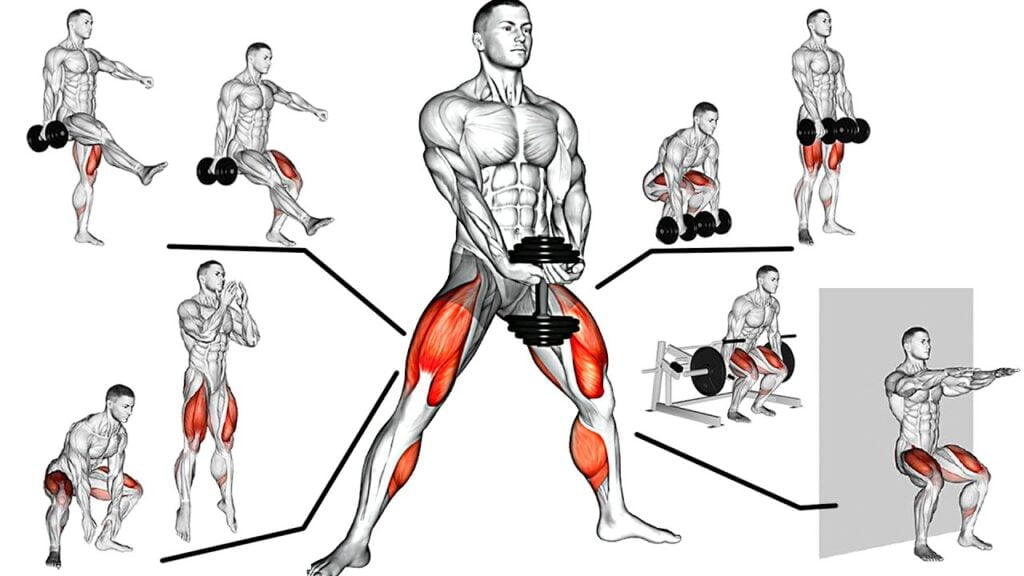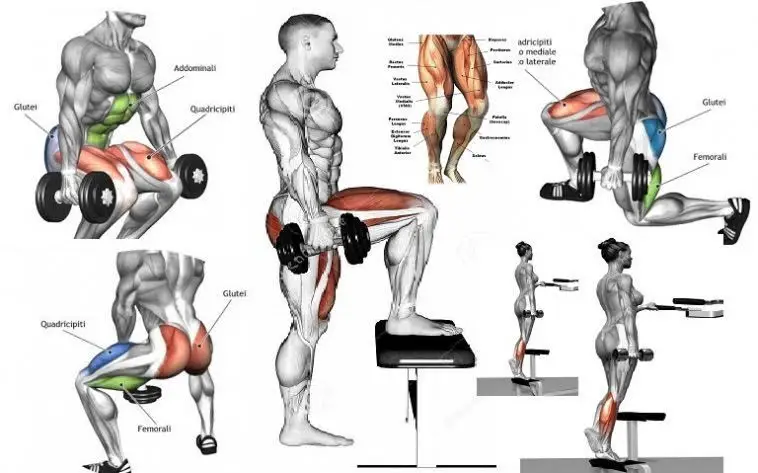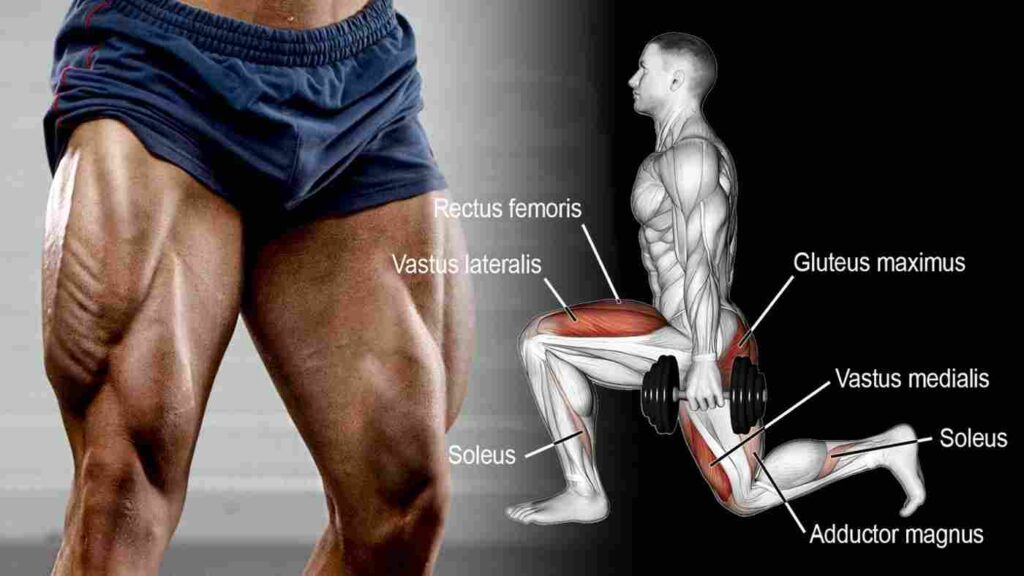Welcome to the ultimate guide on strengthening your quadriceps right in the comfort of your home! The quadriceps, or ‘quads’ for short, are the powerhouse of your lower body. They are the key muscles that sit at the front of your thigh, responsible for stabilizing your knees, propelling you forward in a sprint, and aiding in various daily movements. Whether you’re an athlete looking to enhance performance, someone recovering from an injury, or simply aiming to maintain a healthy and active lifestyle, strong quads are essential.
In this article, we’ll explore a variety of exercises that target these crucial muscles, ensuring you can build strength without the need for a gym membership. From bodyweight basics to more challenging variations, we’ll cover everything you need to know to develop powerful, resilient quads. So, roll out your mat, and let’s get ready to boost your leg strength with practical, effective workouts you can do right at home!
Introduction to Quadriceps
The quadriceps, or ‘quads’, are a group of four muscles located at the front of the thigh. These muscles are key contributors to leg strength and stability, playing a vital role in various movements such as walking, running, jumping, and squatting. Here’s a breakdown of their importance:
- Leg Extension: The primary function of the quadriceps is to extend the knee, which is essential for straightening the leg. This action is crucial for many activities, including standing up from a seated position and climbing stairs.
- Shock Absorption: When you walk or run, your quads act as shock absorbers, reducing the impact on your knee joints.
- Stability: Strong quads ensure better stability of the knee joint, which can prevent injuries and improve balance and posture.
- Athletic Performance: For athletes, well-developed quads can lead to improved performance in sports that require powerful leg movements.
SHOP FOR THE ADJUSTABLE DUMBBELL SET ON AMAZON
Strengthening the quadriceps is therefore important not just for athletes but for anyone looking to maintain a healthy and active lifestyle. Strong quads can help protect against knee pain and injuries, and contribute to better mobility and endurance.
Benefits of Strong Quads
Strong quadriceps offer a multitude of benefits, both in terms of physical performance and overall health. Here are some of the key benefits:
- Improved Athletic Performance: Strong quadriceps muscles are essential for various athletic activities, including running, jumping, cycling, and squatting. They provide power and stability, enhancing performance in sports and activities that require lower body strength.
- Enhanced Mobility: Well-developed quads improve flexibility and mobility in the hips and knees, allowing for a greater range of motion during activities such as walking, running, and climbing stairs.
- Injury Prevention: Strong quadriceps muscles help stabilize the knee joint and protect it from injuries, such as strains, sprains, and tears. This is particularly important for athletes and individuals engaging in high-impact activities.
- Better Posture: Strong quads contribute to proper alignment of the pelvis and spine, promoting good posture. They help support the lower back and reduce the risk of back pain and discomfort.
- Functional Strength: Quadriceps strength is essential for performing everyday tasks, such as standing up from a seated position, lifting objects, and walking upstairs. Strengthening these muscles can improve functional abilities and independence in daily life.
- Metabolic Benefits: Building muscle mass, including the quadriceps, can increase metabolic rate and calorie expenditure, aiding in weight management and overall metabolic health.
- Bone Health: Resistance training for the quadriceps stimulates bone growth and density, reducing the risk of osteoporosis and bone fractures, especially in aging populations.
- Improved Knee Health: Strong quads help distribute forces evenly across the knee joint, reducing the risk of overuse injuries and conditions such as patellofemoral pain syndrome and osteoarthritis.
- Balance and Stability: Strong quadriceps muscles play a vital role in maintaining balance and stability, particularly during dynamic movements and activities that involve changes in direction or uneven surfaces.
- Enhanced Rehabilitation: Rehabilitation programs often include exercises to strengthen the quadriceps after knee injuries or surgeries. Strong quads facilitate faster recovery and improve functional outcomes during rehabilitation.
SHOP FOR THE RESISTANCE BAND ON AMAZON
Overall, developing strong quadriceps muscles is beneficial for both performance and injury prevention in various physical activities, as well as promoting overall health and well-being.
Anatomy of the Quadriceps
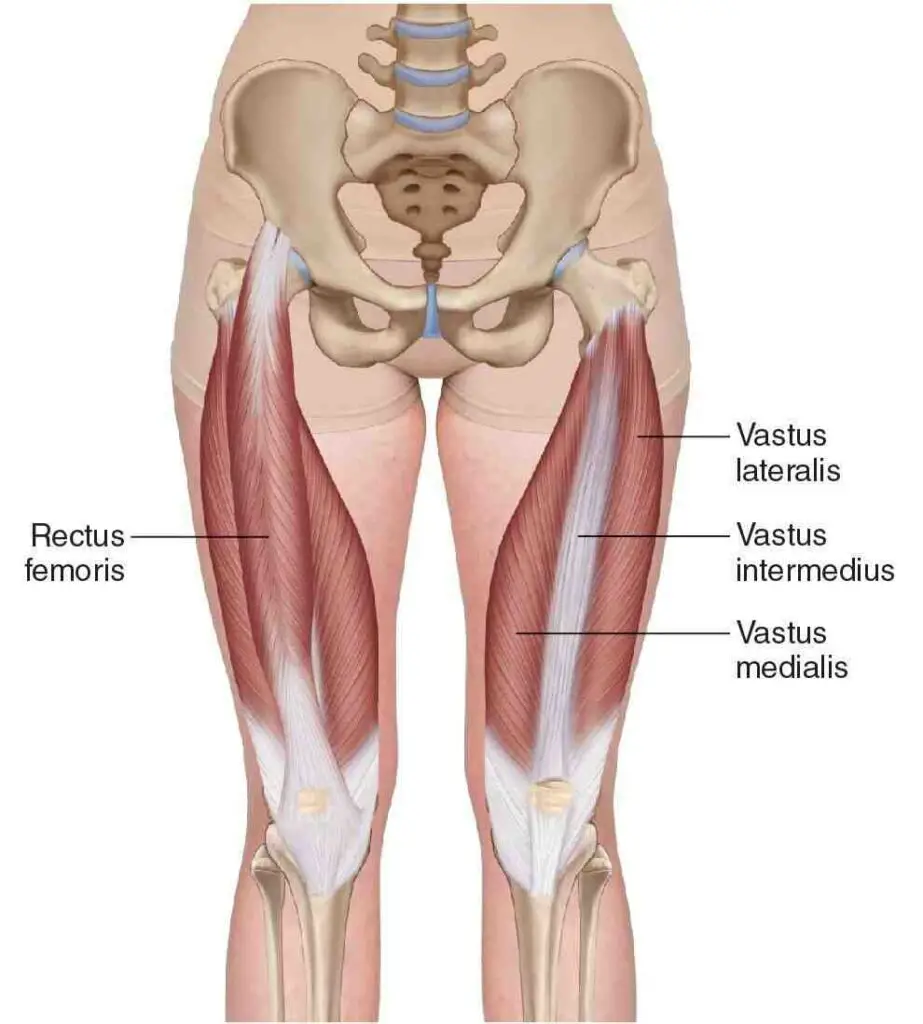
The quadriceps femoris, commonly referred to as the quadriceps, is a group of four muscles located in the anterior (front) thigh. These muscles are crucial for various movements involving the knee joint and are among the strongest muscles in the human body. The four muscles that make up the quadriceps are:
- Rectus Femoris: This is the most superficial muscle of the quadriceps and is situated in the middle of the thigh. It originates from the anterior inferior iliac spine of the pelvis and extends down the thigh to attach to the patella (kneecap) and then to the tibia via the patellar tendon. The rectus femoris is unique among the quadriceps muscles because it also crosses the hip joint, allowing it to assist in flexing the hip in addition to extending the knee.
- Vastus Lateralis: This muscle lies on the lateral (outer) side of the thigh. It originates from the greater trochanter of the femur, the intertrochanteric line, the linea aspera, and the lateral intermuscular septum of the thigh. It inserts into the patella and the tibia via the patellar tendon. The vastus lateralis primarily acts to extend the knee joint.
- Vastus Medialis: Situated on the medial (inner) side of the thigh, the vastus medialis originates from the linea aspera and the medial intermuscular septum of the thigh. Like the vastus lateralis, it inserts into the patella and the tibia through the patellar tendon. The vastus medialis also contributes to knee extension and helps stabilize the patella during movement.
- Vastus Intermedius: This muscle lies deep within the thigh and is located between the rectus femoris and the vastus lateralis. It originates from the anterior and lateral surfaces of the femur, specifically the body of the femur and the upper part of the shaft. It also inserts into the patella and the tibia via the patellar tendon. The vastus intermedius is primarily responsible for extending the knee joint.
SHOP FOR THE FOAM ROLLER ON AMAZON
All four quadriceps muscles work together to extend the knee joint, which is essential for movements such as walking, running, jumping, and squatting. Additionally, the rectus femoris assists in flexing the hip joint, contributing to movements like lifting the leg when walking or climbing stairs. Proper strengthening and conditioning of the quadriceps are vital for overall lower body strength, stability, and functionality.
Exercises to Strengthen Quads at Home
Here are some exercises you can do at home to strengthen your quadriceps:
Straight Leg Raises
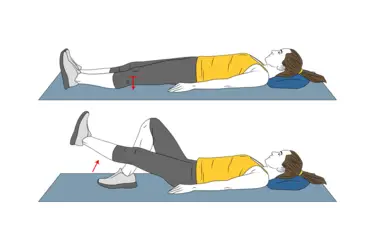
This exercise is performed while lying on your back. One leg should be resting straight on the floor and the other should be bent at the knee with your foot flat on the ground. The exercise involves raising your straight leg toward the ceiling, focusing on keeping your leg straight as you do so. You should hold this position for a few seconds before relaxing your leg back to the floor. This exercise should be repeated for 10-15 reps for 3 sets.
Short Arc Quads
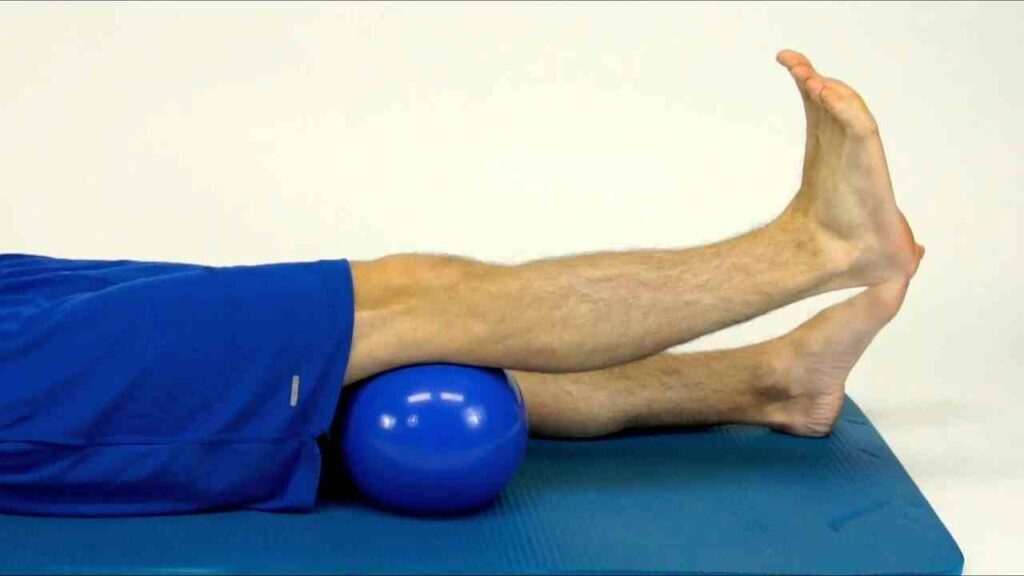
To perform this exercise, you should lie on your back with your knees out straight. Place a bolster under the knee of the quad you wish to strengthen. The exercise involves slowly straightening your knee until your leg is fully straightened while tightening your quad muscle as your knee straightens. You should hold the straight knee position for three to five seconds, and then slowly return to the starting position. This exercise should be repeated for 10-15 reps for 3 sets.
Wall Slides

This exercise is performed while standing upright with your back against a wall and your feet shoulder-width apart. You should bring your arms up, pressing your shoulder blades into the wall. The exercise involves inhaling and bending your knees to slide down the wall until your thighs are parallel to the floor. You should hold this position for 5 seconds before exhaling as you straighten your knees to slide back up the wall until you are fully upright with knees straight and elbows bent back to their starting position. This exercise should be repeated for 10-15 reps for 3 sets.
Chair Pose
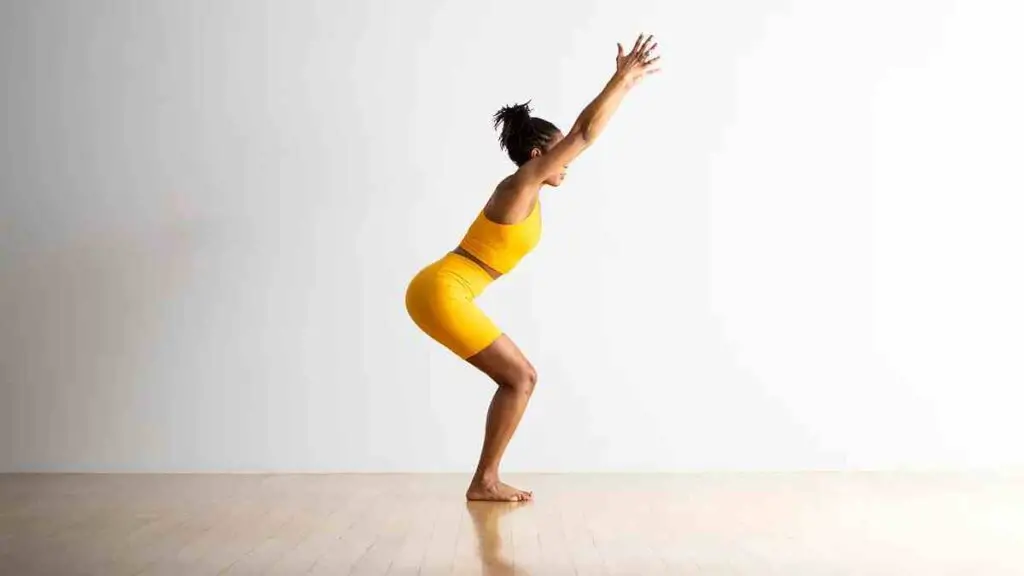
To perform this exercise, you should stand straight and tall with your feet slightly wider than hip-width apart and your arms at your sides. The exercise involves inhaling and lifting your arms next to your ears, stretching them straight and parallel with wrists and fingers long. You should keep your shoulders down and spine neutral. You should then exhale as you bend your knees, keeping your thighs and knees parallel. This exercise should be repeated for 10-15 reps for 3 sets.
Step-ups
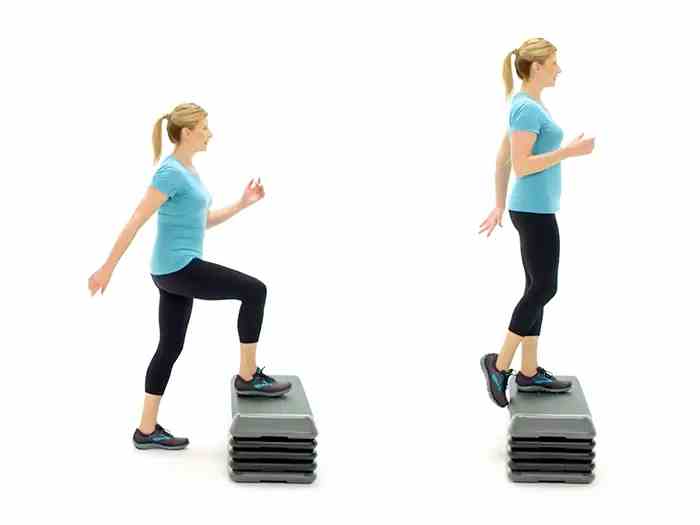
To perform this exercise, you should stand in front of a chair, bench or something else that you can step up on. You should place your foot on the chair and lightly brace your core. The exercise involves stepping up until your leg is straight and then lowering yourself in a controlled motion. You can keep your foot at the chair and repeat for reps. This exercise should be repeated for 10-15 reps for 3 sets.
Sissy Squats

This exercise is performed while standing with a slight bend in your knees. The exercise involves beginning by bending at the knees and lowering your body backward while raising your heels off the ground. You should squat in this fashion as low as you can go while maintaining your balance. This exercise should be repeated for 10-15 reps for 3 sets.
Walking Lunges
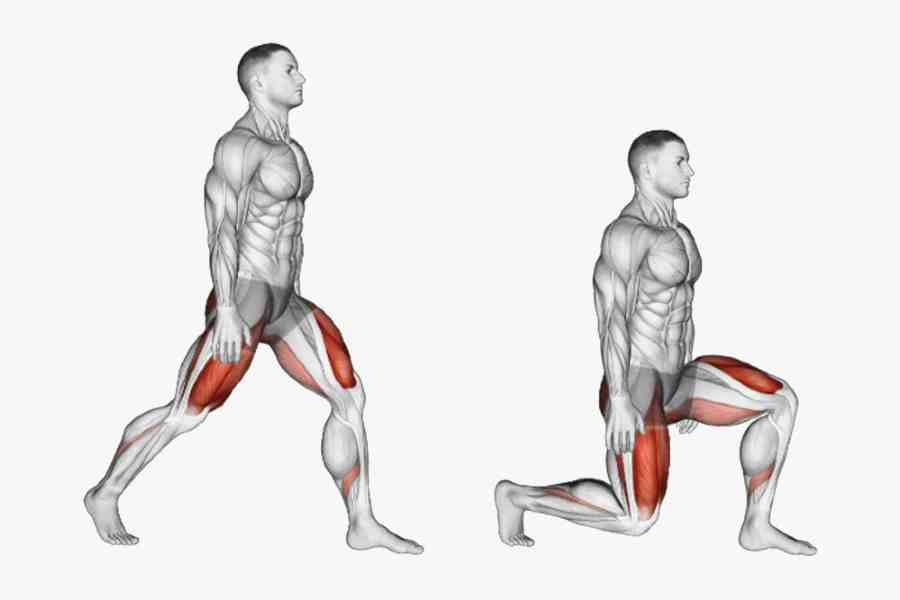
This exercise is performed while standing with your feet roughly hip-distance apart. You should check your posture before starting—your torso should be upright and tall, core engaged, your shoulders back and chin lifted. The exercise involves taking a wide step forward with your right foot—planting it roughly two feet ahead, allowing your left heel to lift naturally as you step forward. You should keep your core engaged and upright. This exercise should be repeated for 10-15 reps for 3 sets.
SHOP FOR THE STABILITY BALL ON AMAZON
Remember to always warm up before starting your workout and cool down afterwards. It’s also important to maintain proper form throughout each exercise to prevent injury. If you’re new to these exercises, you may want to start with fewer reps and sets and gradually increase as your strength improves.
Progression and Variations
When it comes to strengthening your quadriceps at home, progression and variations are key to continuous improvement and avoiding plateaus. Here’s how you can incorporate these concepts into your quad workouts:
- Start with the Basics: Begin with fundamental exercises like bodyweight squats and lunges to establish a solid foundation of strength and technique.
- Increase Difficulty Gradually: As you get stronger, increase the difficulty of your exercises by adding more repetitions, sets, or incorporating single-leg variations to challenge your balance and coordination.
- Use Tempo Changes: Slow down the eccentric (lowering) phase of your exercises or add pauses at the bottom of movements to increase muscle time under tension.
- Add Resistance: Introduce resistance bands, dumbbells, or household items to add weight to your exercises, further challenging your muscles.
- Try Plyometrics: Incorporate jump squats or box jumps to engage the fast-twitch muscle fibers for explosive power.
- Mix It Up: Keep your muscles guessing by regularly changing your workout routine. This can include altering the order of exercises, the type of exercises, or the workout structure.
- Focus on Form: As you progress, continue to prioritize proper form to maximize gains and minimize the risk of injury.
By following these steps, you’ll ensure that your home quad workouts remain effective and engaging, leading to stronger and more defined quadriceps over time.
Frequency and Volume
When planning a workout routine to strengthen your quadriceps at home, understanding the right frequency and volume is crucial for achieving optimal results without overtraining. Here’s a guide to help you determine the appropriate frequency and volume for your quad exercises:
- Frequency: Aim for about 1.5 to 3 workouts per week. This will depend on your current fitness level and the intensity of your workouts. Beginners may start with lower frequency, while more advanced individuals can handle more frequent sessions.
- Volume: Most individuals will benefit from 12 to 18 weekly sets of quad-focused exercises. It’s important to listen to your body and adjust the volume based on how your muscles recover between workouts.
SHOP FOR THE YOGA MAT ON AMAZON
Remember, these are general guidelines, and it’s essential to tailor your workout plan to your individual needs and goals. Always prioritize proper form and technique over the number of sets and reps to prevent injury and ensure the effectiveness of your workouts.
Common Mistakes to Avoid
Training the quadriceps (quads) effectively requires attention to proper form, balanced exercise selection, and adequate recovery. Here are some common errors people make when training their quads and how to avoid them:
1. Neglecting Full Range of Motion (ROM):
- Error: Many people perform exercises like squats or leg presses with partial ROM, limiting the activation and growth of the quads.
- Solution: Focus on performing exercises through a full ROM, ensuring the quads are fully engaged throughout the movement. This promotes muscle development and reduces the risk of injury.
2. Overemphasis on Machines:
- Error: Relying solely on machines for quad training can limit functional strength development and neglect stabilizer muscles.
- Solution: Incorporate free weight exercises such as squats, lunges, and step-ups to engage stabilizing muscles and promote balanced development.
3. Improper Foot Placement:
- Error: Incorrect foot positioning during exercises can lead to poor muscle activation and potential joint stress.
- Solution: Ensure proper foot placement according to the exercise. For example, in squats, feet should be shoulder-width apart with toes pointed slightly outward to engage the quads effectively.
4. Ignoring Progressive Overload:
- Error: Failing to progressively increase resistance or difficulty can stall muscle growth and strength gains.
- Solution: Gradually increase weights, repetitions, or intensity over time to continually challenge the quads and stimulate growth. This can be achieved through weight increments, adding resistance bands, or varying exercise tempo.
5. Poor Core Stability:
- Error: Neglecting core stability can lead to compensatory movements, reducing the effectiveness of quad-focused exercises.
- Solution: Prioritize core engagement and stability during quad exercises by bracing the core muscles and maintaining a neutral spine position. This enhances overall strength and reduces the risk of injury.
6. Inadequate Recovery:
- Error: Not allowing sufficient time for muscle recovery can lead to overtraining and hinder progress.
- Solution: Incorporate rest days into your training routine to allow the quads (and other muscles) time to repair and grow. Additionally, prioritize adequate sleep, hydration, and nutrition to support recovery.
7. Failure to Warm Up Properly:
- Error: Skipping warm-up exercises can increase the risk of injury and decrease performance during quad-focused workouts.
- Solution: Before training, engage in dynamic warm-up exercises to increase blood flow, improve joint mobility, and prepare the muscles for activity. This can include leg swings, lunges, and bodyweight squats.
What Happens If You Don’t Workout Hamstrings?
By avoiding these common errors and implementing proper technique, progression, and recovery strategies, individuals can optimize their quad training for improved strength, muscle growth, and overall fitness.
FAQs
Q 1. How long does it take to see results from quad-strengthening exercises?
Ans. Results can vary based on your starting point, the intensity of your workouts, and your consistency. Generally, you may start to see changes in 4-6 weeks.
Q 2. Are there any specific stretches I should do before and after quad exercises?
Ans. Yes, stretching is important. Dynamic stretches are recommended before your workout, and static stretches can be done post-workout to maintain flexibility.
Q 3. Is it normal to feel sore after quad-strengthening exercises?
Ans. Some soreness is normal as your muscles recover, especially if you’re new to exercising or have increased the intensity of your workouts.
Q 4. How can I avoid knee pain while doing quad exercises?
Ans. Proper form is crucial to avoid knee pain. Ensure your knees don’t extend past your toes during exercises like squats and lunges.
Q 5. What should I do if I experience pain during quad exercises?
Ans. If you experience pain, stop the exercise and assess your form. If pain persists, seek advice from a fitness professional or healthcare provider.
Q 6. Can quad-strengthening exercises help improve my balance?
Ans. Yes, strong quads are important for maintaining balance and stability, which can prevent falls and improve overall mobility.
Conclusion
In conclusion, strengthening your quadriceps at home is a practical and effective way to enhance your leg strength, stability, and overall health. By understanding the anatomy of the quads, incorporating a variety of exercises, and paying attention to proper form and technique, you can achieve significant improvements in your lower body strength.
Remember to progress gradually, listen to your body, and balance your workouts with proper nutrition and rest for recovery. With consistency and dedication, you’ll not only build powerful quads but also contribute to a more active and injury-resistant lifestyle.

Good day, and welcome to Fitthour. My name is Shubham Vijay, and I am a certified personal trainer and nutrition coach with 6 years of experience in the fitness industry. At Fitthour, we specialize in types of training, such as strength training, cardio, or HIIT, and our mission is to help clients achieve their fitness goals and improve their overall health.

